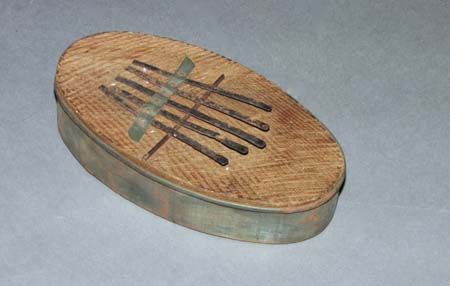
Owner: HWMC
Catalog#: AF-IDPL-13-14
Lamellophones
'Kalimba' (Sardine Can)
Grahamstown, South Africa (Possibly)
Artisan
Wood, metal, tin sardine can
Mid 20th Century
Length: 6.5 inches
Idiophone – Plucked – Lamellophone
This thumb piano (lamellophone) is called a ‘kalimba.’ It was given this name by the English ethnomusicologist Hugh Tracey. In the 1950s Tracy began to introduce this instrument internationally. It is possibly an adaptation of the mbira Nyunga Nyunga of the Shonas ethnic group of Zimbabwe. Nevertheless, it is a small version with only five tongues, played with the thumbs. The larger type (karimba) are emblematic of the Shonas cultures, with 14 to 25 tongues and are held inside a large calabash and played with the thumbs and index fingers.
These lamellophone instruments have several names depending on the geographical area where it is used: likembe, kisanji, sanza or senza in Cameroon and Congo, mbira in Zimbabwe and Malawi, lukeme, karimba in Uganda….
This ‘kalimba’ is made from a sardine can with five (5) metal tongues (keys) attached to a wooden board cut to fit over the opening of sardine can. Shows signs of usage and age.
According to Martin H. Samuel, many of these smaller kalimbas are handcrafted in a family-run workshop in Grahamstown, South Africa.
Special Thanks to Martin H. Samuel for his contributions and clarification to this posting.
